25 years of community understanding and moms’ hard work: The activities of Kinutama Play Village InsightsEssays: Civil Society in Japan
Posted on February 03, 2025
Japan NPO Center (JNPOC) has a news & commentary site called NPO CROSS that discusses the role of NPOs/NGOs and civil society as well as social issues in Japan and abroad. We post articles contributed by various stakeholders, including NPOs, foundations, corporations, and volunteer writers.
For this JNPOC’s English site, we select some translated articles from NPO CROSS to introduce to our English-speaking readers.
25 years of community understanding and moms’ hard work: The activities of Kinutama Play Village
The riverbed of the Tama River as a natural playground
Have you ever heard of the word ‘play park’? It is a playground for children based on the concept of “free play with responsibility”. I would like to introduce Kinutama Asobi-mura (Kinutama Play Village) located in Kamata, Setagaya Ward, near the Tama River in Tokyo.
Translator’s note: Japanese play parks are often community-driven, serving as gathering places for local residents. Since the 1970s, the movement to create adventure playgrounds has expanded from urban areas to towns and rural communities.
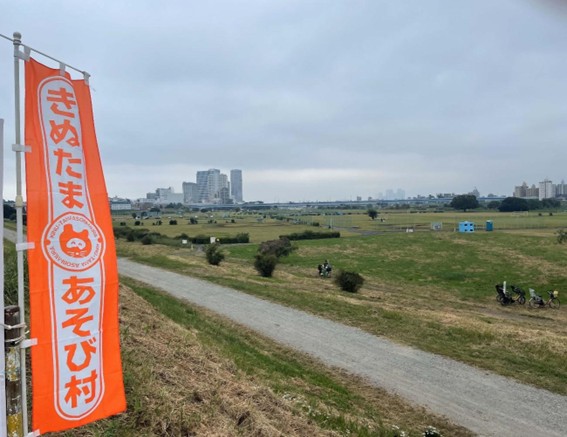
It is nicknamed Kinutama because it is located in the Kinuta area and near the Tama River.
Although Kinutama is not exactly a play park, it is a playground based on the same concept. The playground is staffed by “playworkers,” adults who support children’s play and proactively engage with parents and children who are new to the park or who come to play, creating an atmosphere where they can naturally join the circle of play.
Therefore, the number of visitors ranges from infants and toddlers to elementary school students, junior and senior high school students, and university students (who are often interns and volunteers).
On the day of the interview, there was a group reservation for volunteer childcare. Parents and children enjoyed outdoor cooking and playing in nature on the riverbed with the playworkers.
(*) Activities in which local parents take turns caring for their children instead of leaving them in daycare centers or kindergartens.
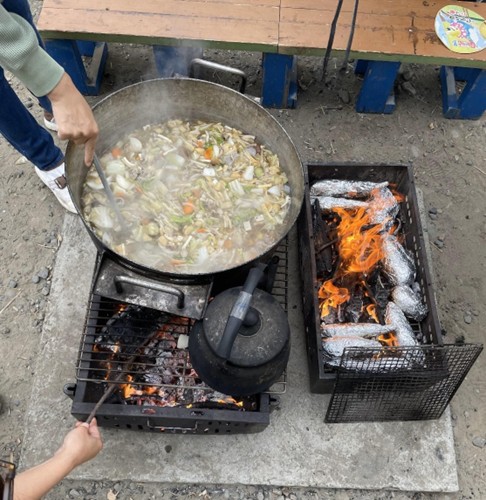
Cooking over an open fire. Today’s menu was splendid!
“Playworkers said, ‘Let’s keep playing every day!’ even during the difficult times of the COVID-19 pandemic,” recalls Ms. Yukiko Uehara, director of Kinuta-Tamagawa Play Village, as she watches over children with their mothers.
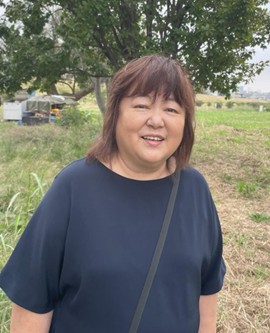
Sachiko Uehara began volunteering to create toys for children with disabilities while she was a student at Musashino Art University. This led her to participate in community development projects run by people with disabilities. After graduating from university and working at an advertising agency for nine years, she founded Kinuta-Tamagawa Play Village at the age of 40. Since 2009, she has been a professor at Musashino Art University.
I asked Ms. Uehara about the reasons and background for starting her activities.
“In 1994, I moved near the Tama River because I wanted to raise my children there. I thought they could run around and play freely every day. But, since the riverbed was sparsely populated on weekdays, the community advised against letting children play there alone. I thought it was a shame to have such a naturally rich area go unused.”
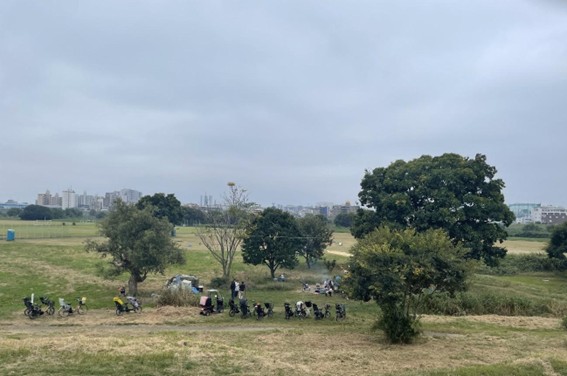
Look down on the field from the top of the bench. Sliding down the bank on cardboard is fun!
She decided to create a playground right there and took the first step.
By posting flyers at a nearby children’s center, she formed the Kinuta Minami Play Park Project in 1999, which later became Kinuta-Tamagawa Play Village. With the help of the children’s center, their dream of a community playground took a giant leap forward with their first event: a water slide party.
Children and their parents must have had a blast sliding down a vinyl sheet on the riverbed slope during those hot summer days.
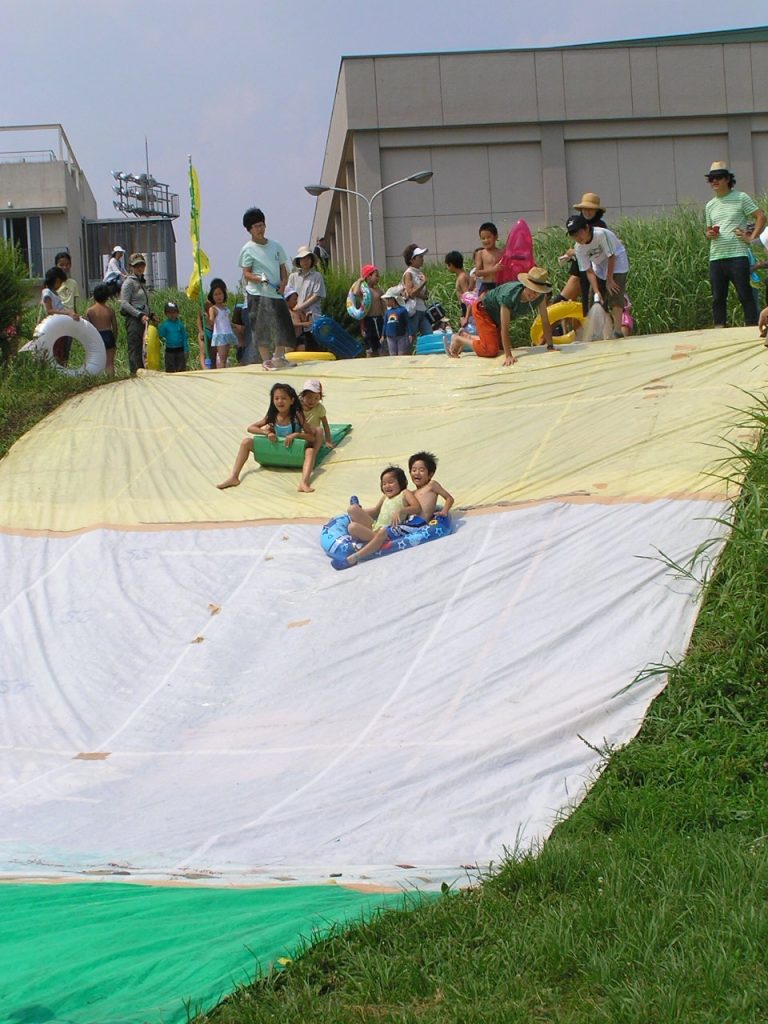
This photo shows what the water slide party actually looked like. (Photo courtesy of Kinuta-Tamagawa Play Village)
Exploring play that might be considered taboo, with adult support
In the same year, Ms. Uehara participated in the planning process for the Tama River Basin River Improvement Plan, successfully advocating for the creation of a riverside playground. The group was renamed the current Kinuta-Tamagawa Play Village and is currently operating mainly projects of Setagaya Ward.
- Operating the Kinuta-Tamagawa Play Village, offering outdoor play activities 4-5 days a week in the Tama River riverbed.
- Managing Kinutama House, a community house located within a short walking distance from the playground, to provide a gathering place for families and children.
- Developing a network of local childcare support coordinators and supporters to provide childcare support and counseling services to families in the community.
In addition to these activities, they also run various outreach programs. They are also in the process of opening a new play park in Okura Sports Park.
The play park promotes “free play with responsibility,” offering activities such as campfires, woodworking, and insect observation. The defining feature of the play park, setting it apart from others, is the presence of a river. They organize twelve river-based activities each summer (commissioned by Setagaya Ward).
As a result, summer field activities are replaced entirely by river activities. Kinutama’s river activities involve wearing life jackets and fully experiencing the Tama River. Participants can dive, snorkel to explore the underwater world, learn about fish and ecosystems from experts, and even identify invasive and native species. Mothers often join in, rediscovering their inner childhood.
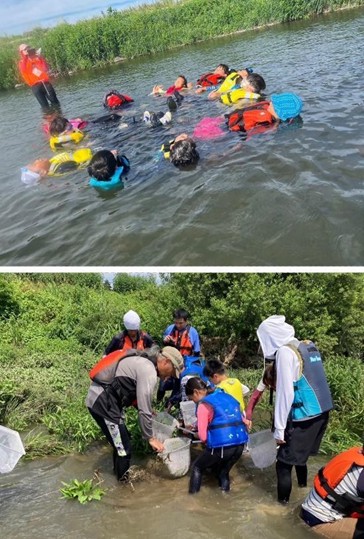
Adjacent to the open field, you’ll find Kinutama House, a play area designed for preschoolers aged 0-3 and their parents/guardians. Here, families can access temporary childcare services and parenting support. It is a valuable space for mothers with very young children who are not quite ready to explore the open field, providing opportunities for connection and community.
Supporting Kinutama House and the play area are individuals called Kosodate Supporters (or parenting supporters). These are mothers who have either reached a turning point in raising their own children or are actively engaged in parenting.
Community strength revealed by the Tama River flood in the 2019 Typhoon
“We’ve always relied on the cooperation of the local community. During that time, we received support from the town council and local construction companies, and we are truly grateful for their help” says Ms. Uehara
“That time” refers to the time when the Tama River was hit by Typhoon 19 on October 12, 2019.
The Tama River flooded, inundating 40 homes and forcing 17,000 people to evacuate in Setagaya and Ota wards.
Ms. Uehara continues: “The Kinutama activity area was devastated… While the surrounding grounds remained untouched until contractors were assigned, Kinutama received permission to clean up the area ourselves. We were able to resume activities in just one month thanks to the recovery efforts, although the cleanup was incredibly challenging. Even with fathers using shovels to move the sediment, it seemed like it would never end. That’s when a local construction company, saying ‘We can’t just watch,’ brought in three heavy machines. Seven employees volunteered and cleared away the accumulated sediment.”
Ms. Uehara, who still actively serves as the representative while working as a university professor, reflects on the past, saying, “Kinutama is a place where diverse people truly support each other.”
Ms. Uehara’s demeanor reveals no hint of the hardships she must have experienced.
I am convinced that her personality has enabled her to involve those around her and realize her aspirations.
Her strong desire to raise children in the area and her ability to execute her plans have attracted like-minded individuals, leading to the creation of Kinutama Play Village.
And she has also succeeded in providing working opportunities for mothers raising children.
Concluding the interview, Ms. Uehara reflected, “Just like the construction workers who came to our aid during the typhoon, we hear from so many people who say, ‘My kids grew up playing at Kinutama.’ It’s truly heartwarming, and it keeps me going.”
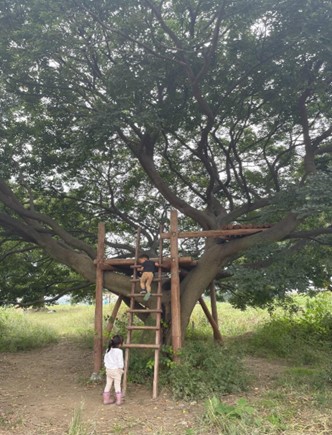
Finally, let me introduce Kinutama Play Village’s symbol tree.
If you look closely, you will notice the first rung of the ladder is the most challenging. It is intentionally designed that way. Rather than telling small children not to climb because it is dangerous, this embodies the playground’s unspoken message: “Free play with responsibility.”
Beyond that first step, there is a world of possibilities waiting for both parents and children.
Come and try climbing this treehouse with your child! You can begin by holding them, then help them along by supporting their bottom. Finally, watch over them as they climb on their own.
This is how parents and children can grow together, step by step, at Kinutama Play Village.
I believe you will discover experiences here that are truly special. I encourage you to come and explore!
Original text by NPO Cross editorial team originally posted on January 17, 2025; translated by JNPOC.
Recent Articles
- A view on realignment in U.S. private philanthropy
- Adapting global goals to local action: The SAVE JAPAN Project approach
- JNPOC and Dentsu’s “Qadai Lab” Launches Column in Forbes Japan
- JNPOC published Report on IT Utilization Survey for Nonprofit Organizations 2025
- JNPOC’s English Annual Report for FY2024 is now available!
- Moving bodies, moving hearts: How DAN DAN RUN connects us to refugee support